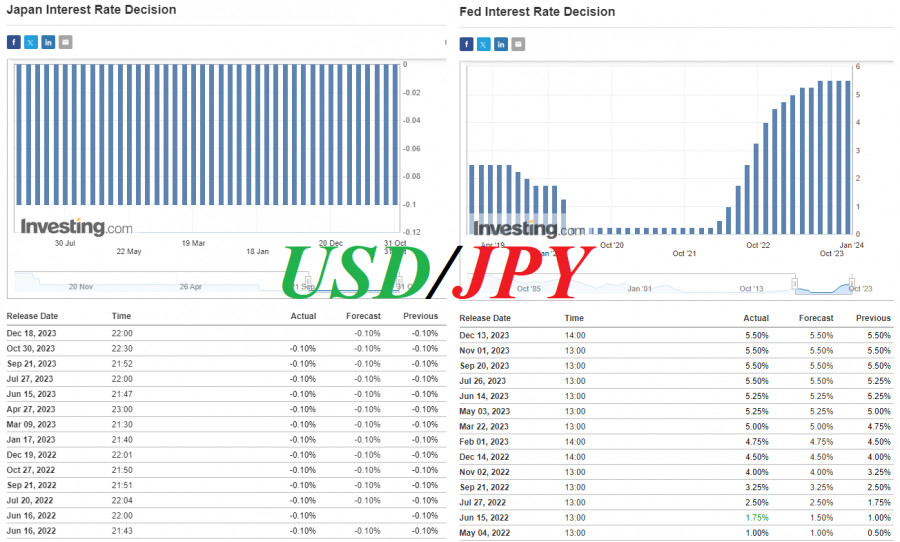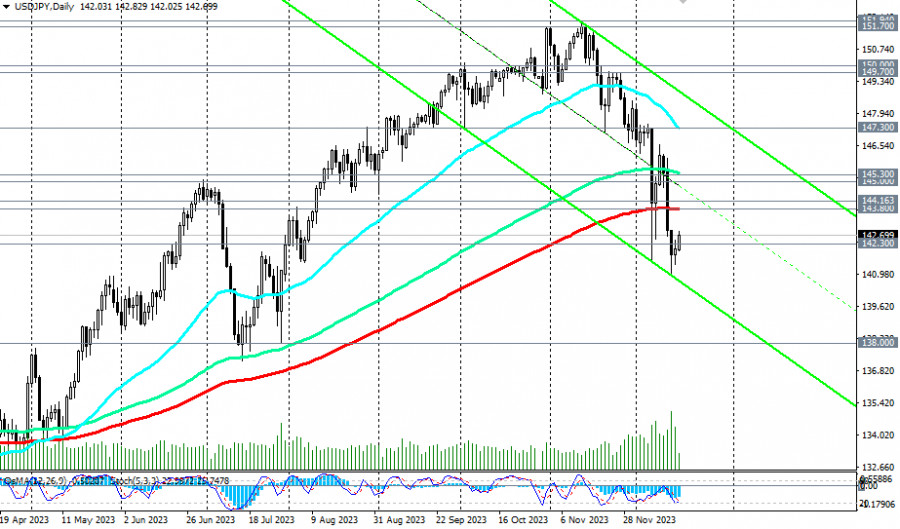อ่านรายละเอียดเพิ่มเติม


 18.12.2023 02:47 PM
18.12.2023 02:47 PMMarket participants enthusiastically embraced the recent comments from the leaders of the Bank of Japan and actively started buying the Japanese yen.
Initially, the USD/JPY pair sharply declined after reports emerged in the media that the head of the Bank of Japan, Kazuo Ueda, had arrived at the office of Prime Minister Fumio Kishida to discuss potential ways to exit the policy of negative interest rates. This significantly fueled discussions about the Bank of Japan abandoning the regime of negative interest rates sooner than expected. Additionally, the Bank of Japan conducted a special survey of market participants to discuss the impact of such a move and its side effects.
As a result, on December 7, the USD/JPY pair sharply declined, staging a powerful rally of 570 points and dropping to a low since early August at 141.60. After a strong correction (to 146.58), the downward rally of the pair resumed following the publication of U.S. inflation data last Tuesday, indicating further deceleration, and then after the Wednesday meeting of the Federal Reserve amid a sharp weakening of the dollar.
Following this meeting, the interest rate was left at 5.50%, and the fresh Fed forecasts "assume a rate cut of 75 basis points from the current level in 2024," four more times in 2025, and three times in 2026, after which it will stand at 2.00%–2.25%.
Speaking at a press conference after the meeting, Federal Reserve Chairman Jerome Powell emphasized that the central bank's leadership "remains focused on the question of whether rates are high enough."
At the same time, according to him, it is unlikely that the Fed will raise rates further, and central bank leaders "are thinking and talking about when it would be appropriate to lower rates."
The overall decline in USD/JPY in this ongoing month is 550 points at the moment, although volatility has reached 740 points. According to Myfxbook.com, the average monthly volatility of USD/JPY is 527 points, and the result of 740 points speaks for itself.
After reaching a 20-week low at 140.95 last Thursday, today, for the second consecutive trading day, USD/JPY is rising and is trading near 142.70 as of writing.
Despite this rise, many economists believe that the yen could strengthen even more next year, provided that the Bank of Japan indeed begins to act towards winding down its long-standing ultra-loose policy.
As known, following the recent October meeting, the members of the Bank of Japan's board decided to leave the current parameters of monetary policy unchanged, maintaining the interest rate and the yield of 10-year Japanese government bonds at levels of -0.10% and 0%, respectively.
Ueda stated in the accompanying statement that it was advisable to make YCC policy more flexible, considering the very high uncertainty in the economy and markets. He mentioned that during market operations, the upper limit of the yield on 10-year JGBs at 1% would be considered a reference point. Additionally, he conveyed that the Bank of Japan would patiently continue to ease monetary policy under YCC to support economic activity and create conditions for more active wage growth during a press conference following the central bank's meeting.
Now, economists predict that the Bank of Japan will end the YCC policy as early as the January meeting, which could strengthen expectations of further policy tightening in 2024.
At present, the USD/JPY pair maintains a general upward trend, and the previous decline can be attributed to the attempt by yen buyers to break it.
From a technical standpoint, USD/JPY has only made the initial attempt to break free from the grip of its buyers, testing the crucial support level of 143.80 that separates the medium-term bullish market from the bearish one.
Despite a relatively deep decline into the zone below this key level (by 285 points), the long-term upward trend of the pair is still intact.
However, once expectations of a trend reversal intensify, there is a risk of a more abrupt and stronger movement.
In the near future, we will likely gain insights into what to expect from the Bank of Japan in 2024 and its early months, as the central bank meeting is scheduled for tomorrow.
It is widely expected that the current parameters of the Bank of Japan's monetary policy will remain unchanged. However, some economists believe that changes to its key parameters will be made at the meeting on January 22–23 against the backdrop of rising wages (averaging 3.58%, the largest increase in about three decades).
Most economists believe that the Bank of Japan will conclude the cycle of ultra-loose monetary policy by the end of 2024, which is still a dovish factor for the yen.
If the market's expectations regarding the start of the unwinding of the Bank of Japan's ultra-loose policy align with expectations of a shift in the vector of the Fed's monetary policy, the downward movement of USD/JPY will intensify.
A re-entry of the price below the 141.00 mark and a break below the local support level of 138.00 may trigger further declines in USD/JPY, confirming negative expectations for the pair.
It is worth noting that the Bank of Japan's interest rate decision will be published on Tuesday after 01:00 (GMT). The Bank of Japan press conference will begin after 05:00 (GMT).
You have already liked this post today
*บทวิเคราะห์ในตลาดที่มีการโพสต์ตรงนี้ เพียงเพื่อทำให้คุณทราบถึงข้อมูล ไม่ได้เป็นการเจาะจงถึงขั้นตอนให้คุณทำการซื้อขายตาม
ค่าเงินยูโรกำลังแสดงการปรับตัวขึ้นอย่างรวดเร็วเมื่อเทียบกับดอลลาร์สหรัฐ คู่สกุลเงิน EUR/USD ได้แตะระดับสูงสุดในรอบสามปีแล้วและยังไม่มีสัญญาณว่าจะชะลอตัวลง ขณะเดียวกัน จากการสำรวจความคิดเห็นของนักเศรษฐศาสตร์ มีความเป็นไปได้ที่เจ้าหน้าที่ของธนาคารกลางยุโรปจะปรับลดต้นทุนการกู้ยืมลงอีกหลายครั้ง ถึงแม้จะมีการคาดการณ์ในท้ายที่สุดว่าพวกเขาจะปฏิบัติตามแนวทางของธนาคารกลางสหรัฐ ผู้ตอบแบบสอบถามคาดว่าจะมีการลดอัตราดอกเบี้ยครั้งละหนึ่งในสี่ในเดือนเมษายนและมิถุนายน ซึ่งหลังจากนั้นอัตราดอกเบี้ยเงินฝากคาดว่าจะคงที่ที่ 2% นักเศรษฐศาสตร์เตือนว่านโยบายการค้าของสหรัฐฯ มีความเสี่ยงสำคัญ ที่อาจกระทบการเติบโตทางเศรษฐกิจของยูโรโซน มาตรการปกป้องที่เพิ่มขึ้น
คู่สกุลเงิน AUD/USD พยายามดึงดูดผู้ซื้อต่างชาติในขณะที่ฟื้นตัวจากระดับจิตวิทยาที่ 0.5900 ซึ่งเป็นจุดต่ำสุดนับตั้งแต่เดือนมีนาคม 2020 พลังขาขึ้นนี้สามารถผ่านระดับ 0.6200 ไปได้ อันมีสาเหตุมาจากความเชื่อมั่นที่เกิดขึ้นจากการยกเลิกการเก็บภาษีของประธานาธิบดีสหรัฐฯ Donald Trump แค่เพียงไม่ถึง 24 ชั่วโมงหลังจากที่มีการกำหนดภาษีใหม่
เมื่อวันพฤหัสบดีที่ผ่านมา นักลงทุนตระหนักว่าในปัจจุบันไม่มีสิ่งที่เรียกว่าเสถียรภาพ ความผันผวนสูงของตลาดยังคงอยู่และจะยังคงครอบงำต่อไปอีกระยะหนึ่ง สาเหตุที่ยังคงดำเนินต่อมาคือสงครามการค้า ซึ่งปัจจุบันถูกมองว่าไม่ใช่การขัดแย้งระหว่างสหรัฐฯ กับยุโรปหรือภูมิภาคอื่นๆ ทั่วโลก แต่เฉพาะเจาะจงว่าเป็นการเผชิญหน้าระหว่างวอชิงตันกับปักกิ่ง เหตุการณ์ล่าสุดเผยให้เห็นว่า การโหมประชาสัมพันธ์เรื่องการเก็บภาษีศุลกากรเกือบทุกประเทศเป็นการปฏิบัติการครอบงำทางเศรษฐกิจ โดยจีนคือคู่แข่งหลักทางเศรษฐกิจ การหยุดพัก 90 วันที่ โดนัลด์
ชีวิตคืออะไรถ้าไม่ใช่เกม? ในช่วงหลายปีที่ผ่านมา นักลงทุนมุ่งเน้นไปที่การเผชิญหน้า ระหว่างธนาคารกลางสหรัฐและตลาดการเงิน แต่ในปี 2025 กฎของเกมได้เปลี่ยนแปลง ตอนนี้ เป็นทำเนียบขาว—ไม่ใช่ธนาคารกลาง—ที่ตลาดต้องการทดสอบความแข็งแกร่งในที่สุด โดนัลด์ ทรัมป์ อ้างว่าการชนะสงครามการค้าจะง่ายดาย แต่การลดลงของ S&P
ในวันศุกร์มีกำหนดการเหตุการณ์ทางเศรษฐกิจมหภาคจำนวนค่อนข้างมาก แต่ไม่มีใดที่คาดว่าจะส่งผลต่อตลาด อย่างไรก็ตาม เราอาจได้เห็นปฏิกิริยาในระยะสั้นต่อรายงานแต่ละฉบับ แต่เป็นที่เข้าใจกันอย่างกว้างขวางว่าตลาดยังคงถูกขับเคลื่อนโดยทรัมป์ การกระทำของเขาจะเป็นตัวกำหนดว่าดอลลาร์สหรัฐจะมีพฤติกรรมอย่างไรในวันสุดท้ายของการซื้อขายของสัปดาห์ และดอลลาร์นั้นจะมีอิทธิพลต่อสกุลเงินอื่นๆ ทั้งหมด รายงานเน้นไปที่ข้อมูล GDP และการผลิตภาคอุตสาหกรรมของสหราชอาณาจักร ดัชนี PCE ของสหรัฐอเมริกา และดัชนีความเชื่อมั่นผู้บริโภคของมหาวิทยาลัยมิชิแกน
คู่สกุลเงิน GBP/USD ก็มีการซื้อขายที่ปรับตัวสูงขึ้นในวันพฤหัสบดี เช่นกัน เป็นที่ทราบกันดีว่าปัจจัยมหภาคและปัจจัยพื้นฐานแบบดั้งเดิมในขณะนี้แทบไม่มีผลกระทบต่อการเคลื่อนไหวของสกุลเงิน สิ่งที่จะสำคัญในขณะนี้คือสงครามการค้าที่ทั่วโลกและข่าวที่เกี่ยวข้อง ดังที่ระบุไว้ในบทความ EUR/USD ว่าในวันพุธเต็มไปด้วยการพัฒนาเกี่ยวกับเรื่องนี้ และในวันพฤหัสบดี ผู้ค้าสามารถประเมินค่า "การหยุดพักชั่วคราว" ของทรัมป์ได้อย่างมีเหตุผลมากขึ้น และการตอบโต้จากตลาดนั้นชัดเจน: ไม่มีการหยุดพัก—เป็นเพียงแนวคิดที่เล่นให้กับสาธารณชน
คู่สกุลเงิน EUR/USD ปรับตัวลดลงอย่างรวดเร็วในคืนวันพุธ แต่มีการฟื้นตัวบางส่วนในช่วงกลางวัน ในวันพฤหัสบดีมีการเติบโตต่อเนื่อง—การแกว่งเหล่านี้สามารถอธิบายได้เพียงว่าเหมือนรถไฟเหาะ การเคลื่อนไหวในปัจจุบันของคู่สกุลเงินสะท้อนถึงปัจจัยพื้นฐานที่เปลี่ยนแปลงอย่างรวดเร็ว และคำแถลงของทำเนียบขาวตอนนี้ดูเหมือนการแสดงตลก เหตุการณ์ในวันพุธเริ่มต้นจากการที่ประเทศจีนตอบโต้การเพิ่มภาษีศุลกากรสินค้านำเข้าของสหรัฐอเมริกาเป็น 84% ทางทำเนียบขาวไม่รอนานและเพิ่มภาษีศุลกากรจีนเป็น 125% จากนั้นมีข้อความจากทำเนียบขาวซึ่งไม่มาจากตัวทรัมป์ตรง ๆ ว่ามีความเป็นไปได้ที่จะเพิ่มภาษีศุลกากรจีนเป็น 500%
คู่สกุลเงิน GBP/USD แสดงการเติบโตแข็งแกร่งในวันพฤหัสบดี แม้จะไม่เทียบเท่ากับคู่ EUR/USD ก็ตาม ปอนด์เพิ่มขึ้นเพียงประมาณ 200 จุด ซึ่งภายใต้สภาวะปัจจุบันไม่ถือว่าเป็นการเคลื่อนไหวที่มากนัก สกุลเงินปอนด์ของอังกฤษ ที่เคยแสดงความแข็งแกร่งเมื่อต่อกรกับดอลลาร์ ตอนนี้กลับเติบโตช้ากว่ายูโร และนั่นทำให้เราประหลาดใจ แต่ก็ไม่ต้องติดใจรายละเอียดเหล่านั้นเลย
รายงาน CPI ที่เผยแพร่เมื่อวันพฤหัสบดีที่ผ่านมาแสดงให้เห็นถึงอัตราเงินเฟ้อที่ต่ำกว่าที่คาดการณ์ไว้ ซึ่งตลาดได้ตอบสนองตามสถานการณ์: ดอลลาร์สหรัฐเผชิญแรงกดดันใหม่อีกครั้ง (ดัชนีดอลลาร์สหรัฐตกลงสู่ระยะ 100.00) และผู้ซื้อ EUR/USD ทดสอบที่ระดับ 1.12 อีกครั้ง ผลลัพธ์นี้ค่อนข้างมีเหตุผล เนื่องจากผู้ที่ลงทุนในดอลลาร์กำลังเผชิญกับช่วงเวลาที่ยากลำบากท่ามกลางความเสี่ยงการถดถอยที่เพิ่มขึ้นในสหรัฐฯ กลับมาที่รายงานเงินเฟ้อ
การเพิ่มขึ้นของดัชนีหุ้นยุโรป, การชะลอตัวของอัตราเงินเฟ้อในสหรัฐอเมริกา, และข้อเท็จจริงที่ว่าอัตราภาษีเฉลี่ยของสหรัฐอเมริกาไม่เปลี่ยนแปลงอย่างมีนัยสำคัญแม้ว่าจะมีการเลื่อนเวลา 90 วันก็ตาม ทั้งหมดนี้ทำให้ค่าเงิน EUR/USD ปรับตัวสูงขึ้น คู่สกุลเงินหลักดูเหมือนว่าพร้อมที่จะฟื้นฟูแนวโน้มขาขึ้นอีกครั้งและดูเหมือนไม่กังวลเกี่ยวกับการชะลอตัวของเศรษฐกิจเยอรมันหรือการลดอัตราดอกเบี้ยเงินฝากที่กำลังจะมาถึงของธนาคารกลางยุโรป การเพิ่มขึ้นอย่างน่าประทับใจของ EuroStoxx 600 เป็นเสียงสะท้อนของการเพิ่มขึ้นทำสถิติของ S&P 500—ซึ่งแข็งแกร่งที่สุดนับตั้งแต่ปี
ตารางของ Forex
เวอร์ชั่นแบบ หน้าเว็บไซต์

Your IP address shows that you are currently located in the USA. If you are a resident of the United States, you are prohibited from using the services of InstaFintech Group including online trading, online transfers, deposit/withdrawal of funds, etc.
If you think you are seeing this message by mistake and your location is not the US, kindly proceed to the website. Otherwise, you must leave the website in order to comply with government restrictions.
Why does your IP address show your location as the USA?
Please confirm whether you are a US resident or not by clicking the relevant button below. If you choose the wrong option, being a US resident, you will not be able to open an account with InstaTrade anyway.
We are sorry for any inconvenience caused by this message.


